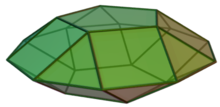| Pentagonal gyrobicupola | |
|---|---|
 | |
| Type | Bicupola, Johnson J30 – J31 – J32 |
| Faces | 10 triangles 10 squares 2 pentagons |
| Edges | 40 |
| Vertices | 20 |
| Vertex configuration | |
| Symmetry group | |
| Properties | convex, composite |
| Net | |
 | |
The pentagonal gyrobicupola is a polyhedron that is constructed by attaching two pentagonal cupolas base-to-base, each of its cupolas is twisted at 36°. It is an example of a Johnson solid and a composite polyhedron.
Construction
The pentagonal gyrobicupola is a composite polyhedron: it is constructed by attaching two pentagonal cupolas base-to-base. This construction is similar to the pentagonal orthobicupola; the difference is that one of cupolas in the pentagonal gyrobicupola is twisted at 36°, as suggested by the prefix gyro-. The resulting polyhedron has the same faces as the pentagonal orthobicupola does: those cupolas cover their decagonal bases, replacing it with eight equilateral triangles, eight squares, and two regular pentagons. A convex polyhedron in which all of its faces are regular polygons is the Johnson solid. The pentagonal gyrobicupola has such these, enumerating it as the thirty-first Johnson solid .
Properties
Because it has a similar construction as the pentagonal orthobicupola, the surface area of a pentagonal gyrobicupola is the sum of polygonal faces' area, and its volume is twice the volume of a pentagonal cupola for which slicing it into those:
References
- ^ Berman, Martin (1971). "Regular-faced convex polyhedra". Journal of the Franklin Institute. 291 (5): 329–352. doi:10.1016/0016-0032(71)90071-8. MR 0290245.
- Francis, Darryl (August 2013). "Johnson solids & their acronyms". Word Ways. 46 (3): 177.



 .
.
 is the sum of polygonal faces' area, and its volume
is the sum of polygonal faces' area, and its volume  is twice the volume of a pentagonal cupola for which slicing it into those:
is twice the volume of a pentagonal cupola for which slicing it into those:
